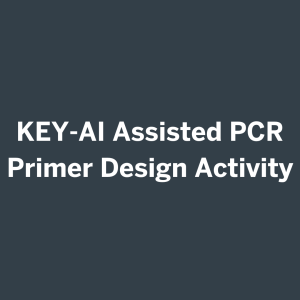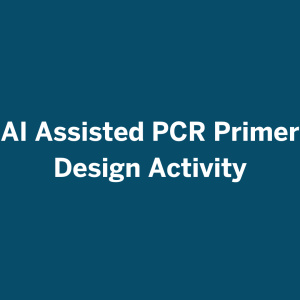13 AI-Assisted Design of Polymerase Chain Reaction Primers (Genetics Lab)
|
|
|
|
|
|
Description of resource(s):
The resources provide an example for how instructors can get students to critically evaluate when AI is used as an “expert” (who has all the information to accurately perform a task) versus as a “coach” (who can guide students in building their own expertise). I accomplished this through an activity in which students used AI (1) to directly design PCR primers and (2) to guide students in how to use expert resources and websites to design PCR primers.
Links to Resources:
Why I implemented this:
In my teaching, I’ve noticed an increasing reliance on AI by students for tasks like data analysis and experiment preparation. However, many students lack critical analysis of the AI-generated results. To address this, I designed an activity emphasizing the importance of field-specific knowledge and the need to carefully evaluate AI results. The activity had two parts:
First, students used AI to design PCR primers and evaluated their quality based on specific criteria to determine their suitability for lab use. In the second part, AI guided them through the primer design process, introducing commonly used PCR design tools and demystifying their use, since these websites are not user-friendly. Students then assessed the second set of primers, similar to the first, to predict lab suitability.
The activity concluded with a homework assignment where students compared the results from both exercises, reflecting on the pros and cons of using AI in lab work. This approach aimed to show students that while AI can be helpful, it should be used as a tool, not a replacement for critical thinking and expert knowledge.
My main takeaways:
In Exercise 1 (using AI as “expert”) only one student out of 150 successfully generated usable primers using AI output. This was mainly due to AI’s frequent errors in determining the reverse complement of the DNA sequence, often adding or removing nucleotides, resulting in non-functional primers. In Exercise 2 (using AI as a “coach”), nearly all students were able to design primers that met lab criteria by using AI coaching. Students found AI helpful for guiding them through the design process, directing them to useful websites, and simplifying complex, user-unfriendly tools.
What else should I consider?
Timing: The instructor’s PPT introduction to primer design takes about 15 minutes to present to students. The PCR primer design activity takes about an hour to complete in person. I had the students each complete this individually on their computer while working side by side with a partner. This allowed students to compare results while still getting the full experience themselves.
Pitfalls to Avoid: Asynchronous Assignments. I recommend having students complete this activity in person. I think if this were done as an asynchronous homework assignment, it would be hard to anticipate/address some of the things that can come up. For example, the AI gave one student computer code to run on their computer to design primers (the student did not ask for this).
Preparation:
- I recommend providing an electronic copy of the activity to your students. There are places in the activity for them to copy/paste and the activity uses the “find” feature (ctrl F) in Microsoft Word (or google docs).
- Trial run a few days before. I also recommend running through the activity very close to when your students will complete the activity. I noticed when I originally created this activity (a couple of months or so before the students completed it), that I got very different results when I “retested” the activity only a few days before the students completed it because there were updates that had been released in the interim.
Adaptation: This type of activity could be modified for a variety of active learning environments, within or outside of biology. The key aspect of this project was taking the standard AI cycle that students are already using and inserting some checkpoints into the process to help students evaluate, discern, and put into context AI results.
Software Alternatives: Most students used Chat GPT, and this tended to give the best result. A small percentage of students used Microsoft Copilot (<10%) and no one used anything else other than those two.








